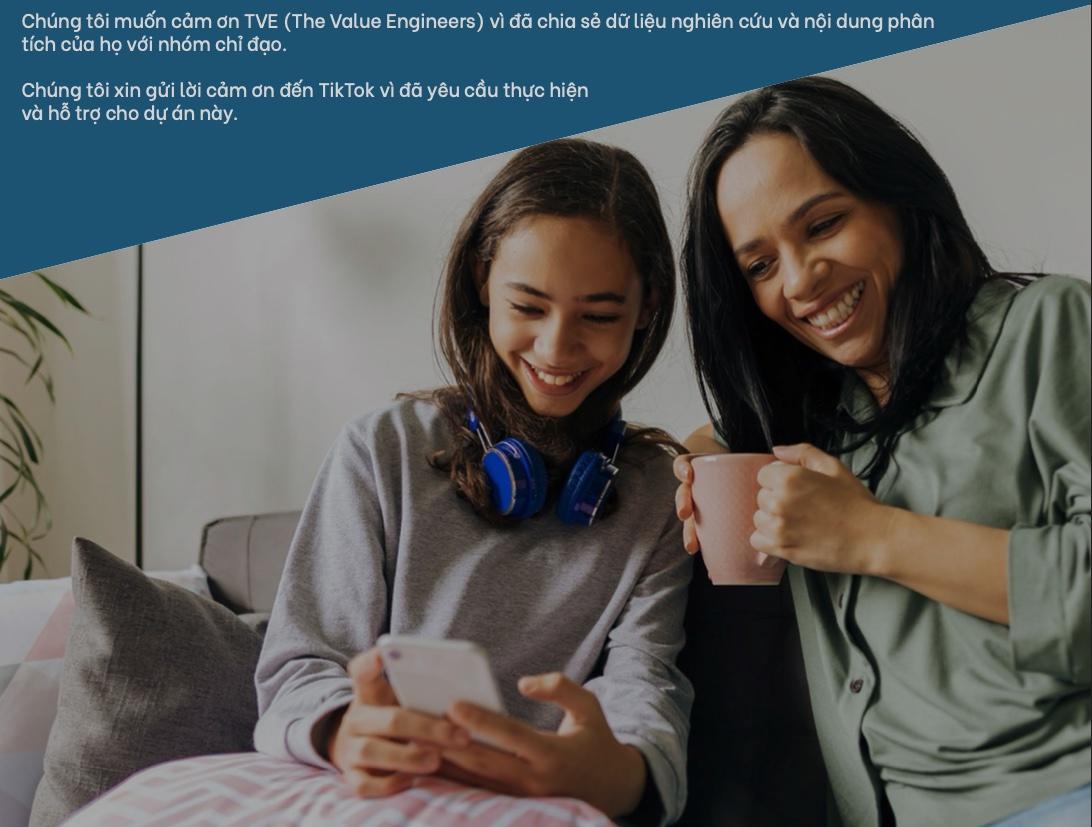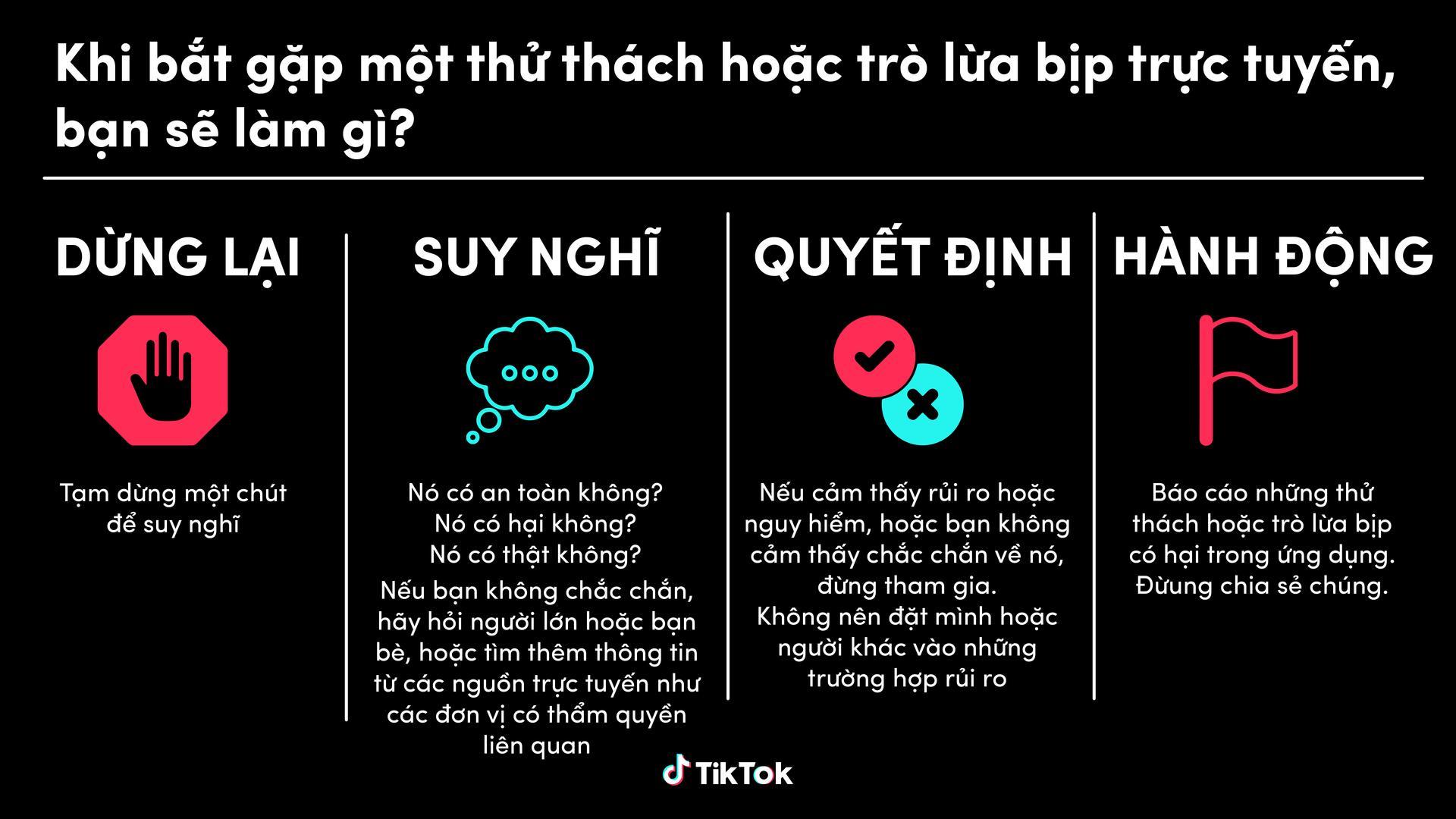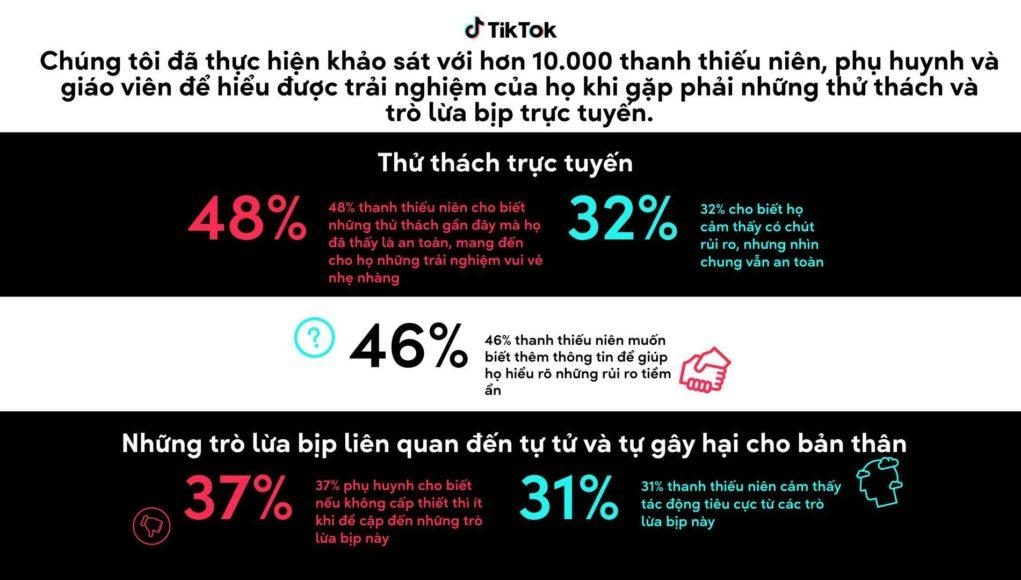Xem nhanh
Today November 18, TikTok releases the report “Understanding dangerous online challenges and effective preventative education responses”
The report is the result of a global project that explores behavioral trends among youth when participating in potentially dangerous challenges or hoaxes leading to suicide or self-harm. TikTok commissions the independent agency Praesidio Safeguarding in research, which surveyed more than 10,000 people from many countries including the UK, Argentina, Brazil, Germany, Indonesia, Mexico, the US, Australia, Italy, and Vietnam. The report also receives contributions and critiques from the world’s leading panel of experts, psychologists and behavioral scientists on child development.
TikTok has become a destination where millions of people around the world connect to entertain, create, find joy in daily life. The TikTok community has always been known for being unique and different, known for trends with Duet and Stitch features to shoot with friends and crop videos and other new initiatives. TikTok has always focuses on safety for users, especially among teenagers to build an open, friendly and creative environment. TikTok is committed to provide parents and guardians in supporting youth safety in cyberspace, and will coordinate and consult with experts to come up with most optimal solutions.

In recent months, TikTok has launched a global project to learn about behavioral trends of youth when participating in potentially dangerous online challenges or hoaxes which can lead to suicide or self-harm.
3 main goals of the project:
- Review and evaluate the effectiveness of responses to suicide and self-harm related challenges.
- Find new ways to better support youth, parents and teachers around the globe.
- Increase public awareness via sharing the reported information.
To accomplish these goals, TikTok has:
- Survey over 10,000 people from Argentina, Australia, Brazil, Germany, Italy, Indonesia, Mexico, UK, USA and Vietnam.
- Authorize the independent agency Praesidio Safeguarding to produce the report, which provides key research findings and recommendations. The report “Understanding Dangerous Online Challenges and Effective Preventative Education Responses” was written by Dr. Zoe Hilton, Director and Founder of Praesidio Safeguarding.
- Bring together a panel of 12 of the world’s leading child safety experts to provide critiques and suggestions on Dr. Hilton’s report. The experts includes Ximena Díaz Alarcón (Argentina), Professor Amanda Third (Australia), Fabiana Vasconcelos (Brazil), Jutta Croll (Germany), Dr. Maura Manca (Italy), Anne Collier (USA), Diena Haryana (Indonesia), Karl Hopwood (United Kingdom), Stephen Balkam (USA), Nguyen Phuong Linh (Vietnam), Daniela Calvillo Anhulo (Mexico) and Dr. Najla Alnaqbi (UAE).
- Collaborate and consult with Dr. Richard Graham – clinical psychiatrist specializing in healthy adolescent development and Dr. Gretchen Brion-Meisels – behavioral scientist specializing in risk prevention for youth.
Lessons from online challenges

Most online challenges are fun and safe. The #icebucketchallenge (“ice bucket challenge”) that raises awareness for amyotrophic lateral sclerosis, or the #BlindingLightsChallenge that unites family members are two typical examples which receive positive response from the online community. Regardless, there is no denying the danger posed by some dangerous challenges that have been spreading recently. Faced with this fact, the research team looked to determine the motivations push adolescents to participate in these challenges, the methods they use to assess risks and find solutions to ensure their safety.
In the study, adolescents were asked to describe the risk levels of recent popular online challenges. Nearly half (48%) of the respondents believe these challenges are safe and fun, 32% think that the challenge is risky but safe, 14% rate it as dangerous, and extremely dangerous is 3%. Only 0.3% of teenagers said they had participated in a challenge they considered dangerous.
The study also found that teens used a range of risk assessment methods before taking on the challenges. These include watching videos of people trying, reading comments, and talking to friends. Empowering and guiding youth in self-reflection and risks assessment is the most effective prevention strategy. Specifically, 46% of the youth surveyed wanted to have information regarding danger level and what was considered over the limit provided.
Discovery from suicide and self-harm hoaxes
What suicide and self-harm hoaxes have in common is the attempt to convince players to believe that what is scary isn’t real. In previous cases, youth were provoked by a fake threatening text message, luring them into increasingly difficult challenges which eventually would lead to suicide. If youth don’t want to suffer the consequences in the threat, they must spread the messages and invite more friends to join the game. While this may seem innocuous, research shows that 31% of teens who have been exposed to these dangerous hoaxes have been negatively affected. 63% within the group felt mentally harmed.
We understand that parents are very cautious when talking to their children about this topic. Many parents are concerned that proactive methods will inadvertently promote curiosity in children who would not otherwise be exposed to the challenge. 56% of parents agree they won’t bring up these hoaxes unless their child mentions first. In addition, 37% of parents believe hoaxes are a very difficult topic to talk about without piqueting their child’s interest.
Step up efforts to protect the community
We have used Dr. Hilton’s research findings to refine policies at TikTok and hope that this report will also become a useful resource for educators, parents, organizations, NGOs and other platforms. In addition, TikTok will continue to improve existing safety features.
The study has also raised alarms about the dangers of self-harm hoaxes. Even when shared for educational purposes, this topic still hurts youth mentally. In addition to removing harmful videos and taking measures to prevent the spread of this dangerous trend, we will remove misleading false warnings which induce confusion and fear. However, we continue to encourage discussions to clarify confusion and provide accurate information regarding the issue on TikTok platform.
Building strong policies alongside aggressive detection and enforcement measures is at the heart of our commitment to safe and welcoming environment for all of our users. TikTok has made technological strides in alerting our safety department when it detects a spike in the number of offending videos in the same hashtag. For example, #FoodChallenge is where users share recipes. In the event of a suspicious offending content related to this hashtag, we will find out the cause and take action to promptly prevent harmful behavior on the platform.
Introducing new resource to support the TikTok user community
Another remarkable finding in this report is that teens, parents, and educators all have the need to access authentic information regarding online scams and challenges. Thus, TikTok has teamed up with Dr. Graham, Brion-Meisels and Anne Collier (Founder and CEO of The Net Safety Collaborative) to develop a brand new resource dedicated to answering questions of the community regarding online challenges and hoaxes. TikTok hopes that this new resource will help parents take the right approach when discussing and guiding their children.
TikTok has also worked with Dr. Graham and Dr. Brion-Meisels to improve the wording of warning labels when users search for content related to challenges and hoaxes. In addition, users are encouraged to visit the Safety Centerto learn more. If users search for keywords related to suicidal hoaxes, we will also display preventative information.
At TikTok, ensuring users safety is always a top priority. These innovations are the testament to our efforts to create an innovative, safe and inclusive environment. TikTok will continue to innovate and accompany users on the good journey ahead.


